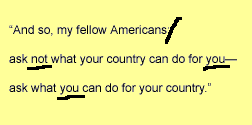 After
you've written your speech, it's time to practice saying it before
you record it for Scholastic.com. There are two main tips to help
you get ready. After
you've written your speech, it's time to practice saying it before
you record it for Scholastic.com. There are two main tips to help
you get ready.
1.
Say It Out Loud
2. Mark Up Your Script
Say
It Out Loud
You can't just mumble to yourself! You must practice reading your
speech like you're really talking to a group. Why?
Mark Up Your Script
What script? Your speech! It's a good idea to think of anything
you write to read aloud as a script. So when your speech is finished,
get a pencil and mark it up. That means actually making
marks on the speech to help you remember how you want to sound when
you record your words aloud.
Professional
announcers, newscasters, and actors do this all the time. And so
do people giving speeches. You can underline words that you want
to emphasize by saying them louder or with more energy. And you
can mark places where you want to pause for dramatic effect, or
where you need to take a breath. There are no special marks to use.
Just make up your own. Maybe put a "P" where you want
to pause.
Here's
an example of a marked-up script. The words are from a speech by
President John F. Kennedy. Can you tell how it was meant to be said?

|